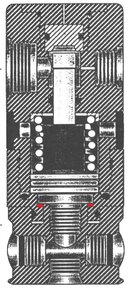Some MK10s don't seem to lock up as immediately as, say MK5s, but creeping from 123 to 145 is really excessive. If one of my MK10s did that I'd take it apart immediately. Basically, when you take a breath or tap the purge, you want to see the IP gauge dip, then come back up to where it was immediately when you stop, and then stay there.
You're right, IP creep is a slow leak at the seat, which causes the piston to need more force to completely seal out HP air from the IP chamber. Higher IP itself is not hard on the seat, because the IP is working against the spring force. For an example, if you add a shim, you increase the spring force, so you need an increase in IP to counteract that. What is hard on the seat would be an increase in the seating force, IOW how much pressure against the seat does the piston need to seal completely. This is primarily a function of how perfectly (or imperfectly) the piston stem edge matches up with the hard plastic seat.
I think the early MK20 pistons were okay; it was the middle generation that had that brass tip. It's obvious when you look at the piston which one you have.
The G250 2nd stage will be fairly tolerant of IP changes, as it's balanced and the rise in IP will result in a corresponding increase in balancing force in the balance chamber. So, you could tune it to a low IP, say 125, and then it might not freeflow at 145.
I have rebuilt MK10s, then not dove them, let them sit for a few months, put an IP gauge on them, and they've creeped a bit. I've found that they need to break in a little. I have never experienced this on a MK5. Awap thinks this must be due to the smaller piston head on the MK10 not providing as much leverage on the piston edge, and as usual, he's probably right. Anyhow, the point is, you could hook the errant MK10 up to a tank, cycle it a few hundred times (light tap on the purge) let it sit pressurized for several hours, cycle some more, then see how it looks.
If you're going to get into reg repair you're of course going to need a tank. Any cheapie will do the job.




